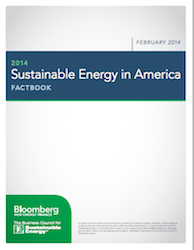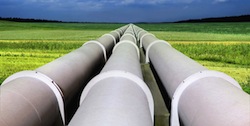Bloomberg New Energy Finance has released the 2014 installment of the Sustainable Energy in America Factbook. The resource was developed for The Business Council for Sustainable Energy, and found that renewable energy, natural gas and energy efficiency advancements are leading a transformation of America’s energy.
The 2014 Factbook documents the upward trajectory of energy efficiency, natural gas and renewable energy, using the latest data from 2013. The report finds renewable energy provided 13 percent of U.S. electricity generation in 2013, up from 12 percent in 2012 and just 8 percent in 2007. At the same time, renewable energy costs reached all-time  lows, allowing clean energy, with the aid of incentives, to be cheaper than fossil fuel electricity in some parts of the country. Small, distributed generators and off-grid installations, meanwhile, began to emerge as a transformative force in the power industry. Financiers who back small-scale solar systems have raised nearly $6.7 billion since 2008.
lows, allowing clean energy, with the aid of incentives, to be cheaper than fossil fuel electricity in some parts of the country. Small, distributed generators and off-grid installations, meanwhile, began to emerge as a transformative force in the power industry. Financiers who back small-scale solar systems have raised nearly $6.7 billion since 2008.
“The U.S. energy transformation that began in the mid-2000s gained additional momentum in 2013,” said Lisa Jacobson, president of The Business Council for Sustainable Energy. “The Factbook plays a vital role in chronicling this fast-moving transformation, which is creating whole new industries and thousands of new jobs in the energy efficiency, natural gas and renewable energy sectors.”
The factbook also found that energy efficiency financing is on an upward trend. Spending by energy service companies and by electric and gas utilities totaled more than $12 billion in 2012. Today 31 states and the District of Columbia, representing 77 percent of the U.S. population, have legislation in place to enable the financing of energy efficiency via property-assessed clean energy programs (PACE). Technology for smart grid and for smart homes is making its way into the market and has potential to be pervasive in the future, driving even further efficiency gains in the years ahead.
“The changes unfolding in the U.S. energy industry have been profound and, by the typical time scale of the industry, abrupt,” said Michel Di Capua, Head of North American Analysis for Bloomberg New Energy Finance. “The effects of these changes will be felt in seemingly every nook and cranny of the American economy, from military bases to manufacturing plants, from homes to highways. 2013 saw some detours from the long-term trends, but overall, it is clear that the long-term transformation of how the U.S. produces and consumes energy continues.”
U.S. natural gas production and consumption reached all-time highs in 2013, solidifying the vital role that gas is playing in building a new energy economy. Investment in the  midstream portion of the industry – mostly pipelines and storage facilities – reached $15 billion. The natural gas share of electricity generation fell slightly from 31 percent in 2012 to 28 percent in 2013, but was still well above the 22 percent share in 2007. The slight dip in 2013 was due to a rebound from historically low gas prices the year before.
midstream portion of the industry – mostly pipelines and storage facilities – reached $15 billion. The natural gas share of electricity generation fell slightly from 31 percent in 2012 to 28 percent in 2013, but was still well above the 22 percent share in 2007. The slight dip in 2013 was due to a rebound from historically low gas prices the year before.
Uncertain and chaotic energy policy in Washington was the biggest speed bump for clean energy in 2013. For example, investment in wind power manufacturing and development slowed dramatically in 2013 due to the late extension of the Production Tax Credit (PTC), after its expiration at the end of 2012. The wind industry installed 600MW in 2013, compared to a record 13.8GW in 2012. Conversely, federal solar tax credits did not require renewal for 2013, which helped propel a dramatic 50 percent increase in cumulative solar installations, making the United States a leader in one of the world’s most dynamic new energy industries.
“We urge legislators and policy makers to clarify and stabilize clean energy policies both at the federal and state levels in order to accelerate America’s energy transformation,” Jacobson stressed. “Clean energy technologies have made major gains in the last five years, and further growth will help reduce greenhouse gas emissions, improve our energy security and strengthen the U.S. economy.”
Global trends in technologies and markets indicate that clean energy sources are positioned to win in the long run. Net energy imports in the U.S. are estimated to have fallen by 15% between 2012 and 2013 and by more than 50% since 2005. Energy efficiency, renewable energy and natural gas are mainly responsible for the nearly 10 percent decline in U.S. greenhouse gas emissions since 2005, taking the country more than halfway to President Obama’s goal of achieving a 17 percent reduction in emissions by 2020.

